
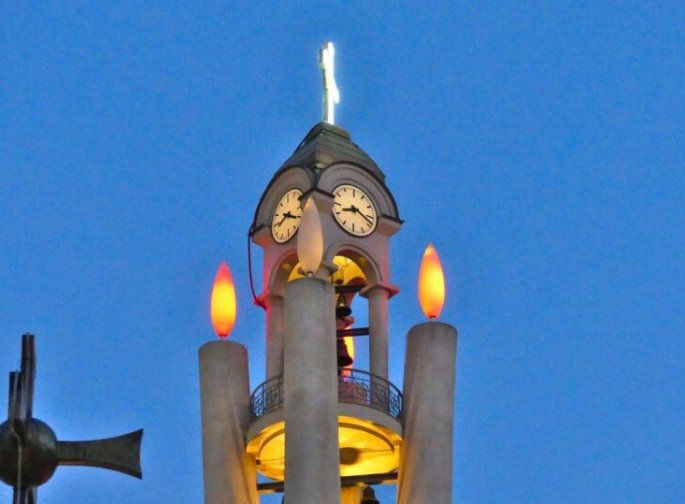
TIRANATirana flourished as a city in 1614 but the region that today corresponds to the city's territory has been continuously inhabited since the Iron Age. The city's territory was inhabited by several Illyrian tribes but had no importance within Illyria. Indeed, it was annexed by Rome and became an integral part of the Roman Empire following the Illyrian Wars. The heritage of that period is still evident and represented by the Mosaics of Tirana. Later, in the 5th and 6th centuries, a Paleochristian basilica was built around this site.After the Roman Empire split into East and West in the 4th century, its successor the Byzantine Empire took control over most of Albania, and built the Petrelë Castle in the reign of Justinian I. The city was fairly unimportant until the 20th century, when the Congress of Lushnjë proclaimed it as Albania's capital, after the Albanian Declaration of Independence in 1912. Tirana is the most important economic, financial, political and trade center in Albania due to its significant location in the center of the country and its modern air, maritime, rail and road transportation. It is the seat of power of the Government of Albania, with the official residences of the President and Prime Minister of Albania, and the Parliament of Albania. The discovery of the Pellumbas Cave near Tirana shows that ancient human culture was present in Albania as early as the Paleolithic era. Nonetheless, the oldest discovery within the urban area of Tirana was a Roman house, which was transformed into an aisleless church with a mosaic floor, dating to the 3rd century, with other remains found near a medieval temple at Shengjin Fountain in the eastern suburbs. A castle possibly called Tirkan, whose remnants are found along Murat Toptani Street, was built by Byzantine Emperor Justinian I and restored by Ahmed Pasha Toptani in the 18th century. The area had no special importance in Illyrian and classical times. Tirana is mentioned in Venetian documents in 1418, one year after the Ottoman conquest of the area: "...the resident Pjeter, son of late Domenik from the village of Tirana...". Records of the first land registrations under the Ottomans in 1431–32 show that Tirana consisted of 60 inhabited areas, with nearly 2,028 houses and 7,300 inhabitants. In 1510, Marin Barleti, an Albanian Catholic priest and scholar, in the biography of the Albanian national hero Skanderbeg, Historia de vita et gestis Scanderbegi Epirotarum principis (The story of life and deeds of Skanderbeg, the prince of Epirotes), referred to this area as a small village, distinguishing between "Little Tirana" and "Great Tirana". It is later mentioned in 1572 as Borgo di Tirana. |
 |
 |
According to Hahn, the settlement had already started to develop as a bazaar and included several watermills, even before 1614, when Sulejman Bargjini, a local ruler, built the Old Mosque, a small commercial centre, and a hammam (Turkish bath). This is confirmed by oral sources, which state that there were two earlier mosques 300–400 m from the Old Mosque, towards today's Ali Demi Street. The Mosque of Reç and the Mosque of Mujo were positioned on the left side of the Lana river and were older than the Old Mosque. Later, the Et'hem Bey Mosque, built by Molla Bey of Petrela, was constructed. It employed the best artisans in the country and was completed in 1821 by Molla's son Etëhem, who was also Sulejman Bargjini's great-nephew.In 1800, the first newcomers arrived in the settlement, the so-called ortodoksit. They were Vlachs from villages near Korçë and Pogradec, who settled around modern day Tirana Park on the Artificial Lake. They started to be known as the llacifac and were the first Christians to arrive after the creation of the town. In 1807, Tirana became the center of the Subprefecture of Kruja-Tirana. After 1816, Tirana languished under the control of the Toptani family of Kruja. Later, Tirana became a sub-prefecture of the newly created Vilayet of Shkodër and the Sanjak of Durrës. In 1889, the Albanian language started to be taught in Tirana's schools, and the patriotic club Bashkimi was founded in 1908. On 28 November 1912, the national flag was raised in agreement with President Ismail Qemali. During the Balkan Wars, the city was temporarily occupied by the Serbian army and it took part in uprising of the villages led by Haxhi Qamili. In August 1916, the first city map was compiled by the specialists of the Austro-Hungarian army. Following the capture of the town of Debar by Serbia, many of its Albanian inhabitants fled to Turkey, the rest went to Tirana. Of those that ended up in Istanbul, some of their number migrated to Albania, mainly to Tirana where the Dibran community formed an important segment of the city's population from 1920 onward and for some years thereafter. On 8 February 1920, the Congress of Lushnjë proclaimed Tirana as the temporary capital of Albania, which had gained independence in 1912. The city acquired that status permanently on 31 December 1925. In 1923, the first regulatory city plan was compiled by Austrian architects. The centre of Tirana was the project of Florestano Di Fausto and Armando Brasini, well-known architects of the Mussolini period in Italy. Brasini laid the basis for the modern-day arrangement of the ministerial buildings in the city centre. The plan underwent revisions by Albanian architect Eshref Frashëri, Italian architect Castellani and Austrian architects Weiss and Kohler. The modern Albanian parliament building served as an officers' club. It was there that, in September 1928, Zog of Albania was crowned King Zog I, King of the Albanians. Tirana was the venue for the signing of the Pact of Tirana between Fascist Italy and Albania. In 1939, Tirana was captured by Fascist forces, who appointed a puppet government. In the meantime, Italian architect Gherardo Bosio was asked to elaborate on previous plans and introduce a new project in the area of present-day Mother Teresa Square. A failed assassination attempt was made on Victor Emmanuel III of Italy by a local resistance activist during a visit to Tirana. In November 1941, two emissaries of the Communist Party of Yugoslavia (KPJ), Miladin Popović and Dušan Mugoša, called a meeting of three Albanian communist groups and founded the Communist Party of Albania, and Enver Hoxha soon emerged as its leader. The town soon became the center of the Albanian communists, who mobilized locals against Italian fascists and later Nazi Germans, while spreading ideological propaganda. On 17 November 1944, the town was liberated after a fierce battle between the Communists and German forces. The Nazis eventually withdrew and the communists seized power. |
 |
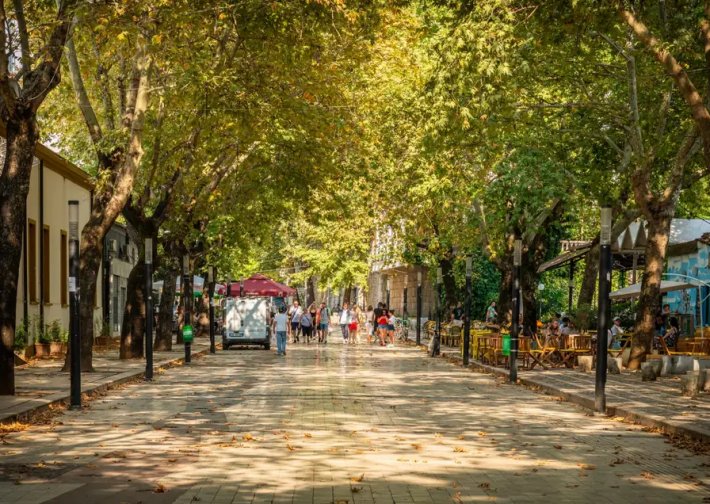 |
From 1944 to 1991, massive socialist-style apartment complexes and factories were built, while Skanderbeg Square was redesigned, with a number of buildings demolished. For instance, Tirana's former Old Bazaar and the Orthodox Cathedral were razed to the ground in order to build the Soviet-styled Palace of Culture. The northern portion of the main boulevard was renamed Stalin Boulevard and his statue was erected in the city square. Because private car ownership was banned, mass transportation consisted mainly of bicycles, trucks and buses. After Hoxha's death, a pyramidal museum was constructed in his memory by the government.Before and after the proclamation of Albania's policy of self-imposed isolationism, a number of high-profile figures paid visits to the city, such as Soviet leader Nikita Khrushchev, Chinese Premier Zhou Enlai and East German Foreign Minister Oskar Fischer. In 1985, Enver Hoxha's funeral was held in Tirana. A few years later, Mother Teresa became the first religious figure to visit the country after the end of Albania's long anti-religious atheist stance. She paid respects to her mother and sister resting at a local cemetery. Starting at the campus and ending at Skanderbeg Square with the toppling of Enver Hoxha's statue, the city saw significant demonstrations by University of Tirana students demanding political freedoms in the early 1990s. On the political aspect, the city witnessed a number of events. Personalities visited the capital, such as former U.S. Secretary of State James Baker and Pope John Paul II. The former visit came amidst the historical setting after the fall of communism, as hundreds of thousands were chanting in Skanderbeg Square Baker's famous saying of "Freedom works!". Pope John Paul II became the first major religious leader to visit Tirana, though Mother Teresa had visited few years prior. During the Balkans turmoil in the mid-1990s, the city experienced dramatic events such as the unfolding of the 1997 unrest in Albania and a failed coup d'état on 14 September 1998. In 1999, following the Kosovo War, Tirana Airport became a NATO airbase, serving its mission in the former Yugoslavia. Starting in 2000, former Tirana mayor Edi Rama (mayor from 2000 to 2011) under the Ilir Meta government, undertook a campaign to demolish illegal buildings around the city centre and along the Lana River banks to bring the area to its pre-1990 state. In an attempt to widen roads, Rama authorized the bulldozing of private properties so that they could be paved over, thus widening streets. Most main roads underwent reconstruction, such the Ring Road (Unaza), Kavaja Street and the main boulevard. Rama led the initiative to paint the façades of Tirana's buildings in bright colours (known as Edi Rama colours – very bright pink, yellow, green, violet) although much of their interiors continued to degrade. Rama's critics claimed that he focused too much attention on cosmetic changes without fixing any of the major problems such as shortages of drinking water and electricity. A richer calendar of events was introduced and a Municipal Police force established. Since 2005 the southeast region of Tirana, mainly Farke and Petrela has had a burst becoming the preferred destination with many residence complexes being built and having the current biggest mall in Albania, the Tirana East Gate (TEG). In 2007, U.S. President George W. Bush marked the first time that such a high ranking American official visited Tirana. A central Tirana street was named in his honor. In 2008, the Gërdec explosions were felt in the capital as windows were shattered and citizens shaken. On 21 January 2011, Albanian police clashed with opposition supporters in front of the Government building as cars were set on fire, three persons killed and 150 wounded. In 2016, Skanderbeg Square was redesigned according to an earlier plan brought forward in 2010. This included greater green space areas around the square, underground parking, and the introduction of stone material taken from all corners of Albania and Albanian-inhabited lands. Albania's rich flora were represented by the gardens around the square, while the former garden behind Skanderbeg's monument was restored to its pre-2010 state and named Europe Park. Once the project is completed, the square will serve as a venue for the annual Christmas Village of Festivities, music concerts, and where surrounding institutions would showcase themselves in an open environment concept such as in the yearly Nuit Blanche on November 29. The New Boulevard (Albanian: Bulevardi i Ri) was opened recently north of Zog I Boulevard at the defunct Tirana Rail Station, laying the foundation for the development of Tirana north of Skanderbeg Square and south of the Tirana River. The new headquarters of Tirana City Hall are planned to be built along the New Boulevard together with a central park located nearby. The architect Stefano Boeri was contracted to work on the General Urban Plan of Tirana (TR030), which makes a series of interventions to the city's infrastructure. The plan was submitted for approval to the Municipality Council in November 2016. |
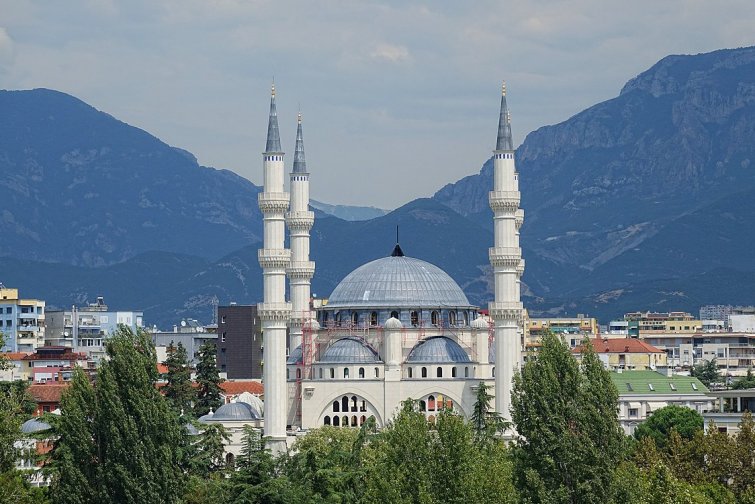 |
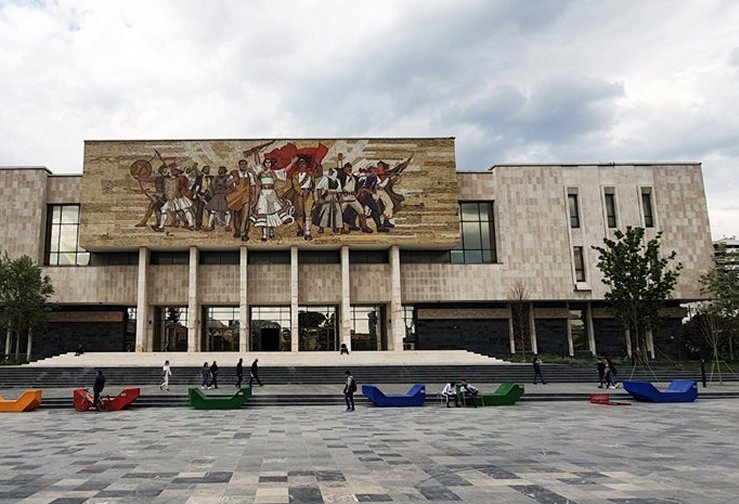 |
Tirana is home to different architectural styles that represent influential periods in its history dating back to the antiquity. The architecture of Tirana as the capital of the country was marked by two totalitarian regimes, by the fascist regime of Benito Mussolini during World War II and the communist regime. Both have left their mark on the city with their typical architecture.In addition to the objects of the architecture of the totalitarian regimes of the 20th century, Tirana offers a couple of other such objects of both periods. The Palace of Brigades (former Palace of the Albania's King Zog I), the ministries buildings, the government building and the municipality hall are designed by Florestano Di Fausto and Armando Brasini, both well-known architects of the Mussolini period in Italy. The Dëshmorët e Kombit Boulevard was built in 1930 and given the name King Zog I Boulevard. In the communist period, the part from Skanderbeg Square up to the train station was named Stalin Boulevard. The Royal Palace or Palace of Brigades previously served as the official residence of King Zog I. It has been used by different Albanian governments for various purposes. Because of the outbreak of World War II, and the 1939 Italian invasion of Albania, King Zog I fled Albania and never had a chance to see the Palace fully constructed. The Italians finished it and used it as the Army Headquarters. The Palace took its nickname Palace of Brigades because it was taken from the Italians by a people's army brigade. In the 21st century, Tirana turned into a proper modernist city, with large blocks of flats, modern new buildings, new shopping centres and many green spaces. In June 2016, the Mayor of Tirana Erion Veliaj and the Italian architect Stefano Boeri announced the start of the works for the redaction of the Master Plan Tirana 2030. The city of Tirana is a densely-built area but still offers several public parks throughout its districts, graced with green gardens. With an area of 230 hectare, the Grand Park is the largest park in the city. It is one of most visited areas by local citizens. The park includes many children's playgrounds, sport facilities and landmarks such as the Saint Procopius Church, the Presidential Palace, the Botanical Gardens, the Tirana Zoo, the Amphitheatre, the Monument of the Frashëri Brothers and many others. The Rinia Park was built during the Communist regime in Albania. It bordered by Dëshmorët e Kombit Boulevard to the east, Gjergi Fishta Boulevard and Bajram Curri Boulevard to the south, Rruga Ibrahim Rugova to the west and Rruga Myslym Shyri to the north. The Taivani Center is the main landmark in the park and houses cafés, restaurants, fountains, and a bowling lane in the basement. The Summer Festival takes place every year in the park, to celebrate the end of winter and the rebirth of nature and a rejuvenation of spirit amongst the Albanians. As of the current Mayor of Tirana Erion Veliaj, the Municipality of Tirana will build more green spaces and will plant more trees.
|
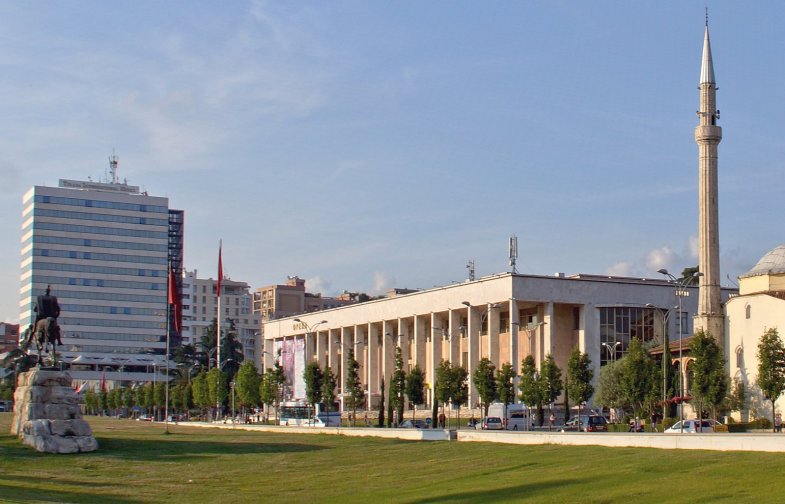 |
 |
CultureTirana is an important center for music, film, theatre, dance and visual art. The city is host to the largest cultural institutions of the country, such as the National Theatre and the National Theatre of Opera and Ballet, the Natioan Archaeological Museum, the Art Gallery of Albania, the Sciences Museum of Albania and the National Historical Museum. Among the local institutions are the National Library, that keeps more than a million books, periodicals, maps, atlases, microfilms and other library materials. The city has five well-preserved traditional houses (museum-houses), 56 cultural monuments, eight public libraries. Since 2011, a Tourist Information Office was opened, located behind the National Historical Museum, with useful information about Tirana and Albania. There are many foreign cultural institutions in the city, including the German Goethe-Institut, Friedrich Ebert Foundation and the British Council. Other cultural centers in Tirana are, Canadian Institute of Technology, Chinese Confucius Institute, Greek Hellenic Foundation for Culture, Italian Istituto Italiano di Cultura and the French Alliance Française. The Information Office of the Council of Europe was established in Tirana. The three main religions in Albania, which contains Islam, Orthodox and Catholic Christianity, have all their headquarters in Tirana. The Bektashi leadership moved to Albania and established their World Headquarters also in the city of Tirana. One of the major annual events taking place in Tirana each year is the Tirana International Film Festival. It was the first international cinema festival in the country and considered as the most important cinematic event in the country.
Museums Other large museums include the National Archaeological Museum, which was the first museum created after World War II in Albania. The National Art Gallery opened to the public in 1954, preserving over 5000 artworks. Other museums include the Natural Sciences Museum, which has branches in zoology, botany and geology, the former Enver Hoxha Museum and the Bunk'art Museum. In 2017, the Museum of Secret Surveillance (House of leaves) were renovated and re-opened. The historical building from the communist period, aims now portray from the omnipresence of the Albanian communist regime.
Coffee culture and Cuisine Tirana's restaurant scene has evolved recently characterized by stylish interiors and delicious food grown locally. The Tirana region is known for the Fergesa traditional dish made with either peppers or liver, and is found at a number of traditional restaurants in the city and agri-tourism sites on the outskirts of Tirana. |